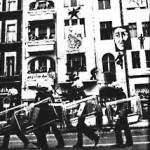East Berlin’s squatter movement erupted across the city after the fall of the wall in 1989. But what role did housing activists in the 1980s play in shaping an alternative vision for the contemporary city?
In September 1988, an anonymous report appeared in the East German underground magazine Umweltblätter describing the plight of a group of squatters who had occupied 61 Lychenerstrasse in the Berlin district of Prenzlauer Berg. In the squatters own words, they had “occupied the house in order to overcome the contradiction between, on the one hand, the many vacant and decaying houses [in Berlin], and on the other, a growing number of people in search of housing”. As “squatters (Instandbesetzer),” they proclaimed, “we will resist the further cultural and spiritual devastation of the country.”[i]
[Read More]

